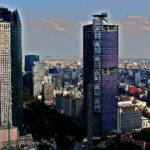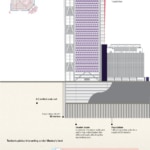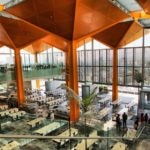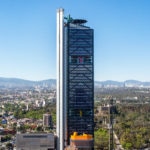How can a 50-story high-rise survive an earthquake?
“The images of buildings crumbling and the dust will stay with me for the rest of my life.” This is the phrase most repeated by BBVA Bancomer employees who, from the different floors of the Tower, witnessed one of the most devastating earthquakes ever to strike Mexico. One month after the quake, we discover some of the secrets that allow a 235-meters-tall colossus to stand.

Right after the emergency drill commemorating the 32nd anniversary of the most destructive earthquake ever to hit Mexico City, the ground started shaking (7.1 degrees on the Richter scale). The earthquake started at 1.14 pm on September 19th. “We felt a strong shock that shook us and Seemed like a prank at first, but with all the motion, we soon realized that, once again, this was the real thing. That’s when the confusion started. I had a hard time telling my parent’s that I was ok. My hands were shaking and it was hard for me to type: Dad, I’m ok, tell mom and turn on the T.V. please. Something bad has happened, some buildings have collapsed.”
Earthquakes cannot be prevented and are virtually unpredictable, and the only measure that can be adopted against them is preparedness. In the wake of the devastating 1985 earthquake, Mexico City passed a new building code. This construction standard regulates everything from materials to the technology used to construct a building, including the people involved in the works.

Anti-seismic measures of the BBVA Bancomer Tower.
Preventing buildings from collapsing is essential, especially in the case of a 50-story high-rise such as the Bancomer Tower, where some 5,000 people work. The key challenge for engineers in these cases is being able to combine resilient and ductile materials in load-bearing elements such as beams and pillars. Earthquakes subject buildings to horizontal loads that can result in structural failure and the vertical collapse of a building, or cause non-structural elements of the construction – such as walls—to break off and fall.
Besides being built on an earthquake prone area - 80% of earthquakes around the world occur along the so-called circum-Pacific Belt - Mexico City has some geological particularities. The city stands atop a lakebed, now filled with sediments, posing many challenges for construction experts. Finding the first layer of harder rock requires digging to great depths. According to
Óscar de Buen, one of the engineers responsible for designing the BBVA Bancomer Tower, "Mexico City’s soil was the biggest challenge we faced during the construction of the BBVA Bancomer Tower." It required us to build our foundations to a typical depth of 50 meters to preserve the stability of the tower, which, at about 200 meters in height, is one of the city’s tallest. During an earthquake the foundation absorbs the energy arriving at the external structure, relieving it from stress. And this was exactly what happened during the earthquake,” says Óscar de Buen.
Alejandro Jiménez, of BBVA Bancomer's Internal Communications area, admits that he was struck by a feeling of disbelief when he first felt the strong movement, aware that he was standing 200 meters above ground. But incredulity turned into confidence when he realized that the tower was moving with, "not fighting against " the earthquake. "Anxiety and gratitude" says Alejandro, "for being here and not where structures collapsed.” Alejandro extends his gratitude "to the security and emergency response teams who properly and timely informed us about the areas where we needed to stay.” That feeling of safety was shared by many co-workers, "knowing that the BBVA Bancomer Tower didn’t bear any structural damages, and that the building is designed to withstand much stronger earthquakes, and knowing that only some non-structural fixtures suffered minor damages."

Open spaces are the main feature of the tower.
Óscar de Buen explains that the construction of a skyscraper in a city with Mexico City’s characteristics is always a challenge. The six perimeter megacolumns that can be seen on the outside of the building, are filled with reinforced concrete and measure more than 2.5 square meters at their base. These megacolumns bear the entire tower’s weight, enabling the building to have an open floor plan, without the need for internal columns (one of the characteristics of the tower).
Among the standouts of the external structure are the inverted V-shaped megaframes, capable of absorbing energy in the event of an earthquake and conveying it from the top of the building to the deep foundation structure. These megaframes create the honeycomb structure surrounding the tower. Each megaframe spans three levels of offices and provides complete lateral resilience and antiseismic ductility. The elasticity of the frames protects the remainder of the structure from typical earthquake-induced damage, dissipates gravity build-up and column loads and avoids stiffness. If, for some external reason, one of the megacolumns were to disappear, the megaframes would keep the building standing.
Tom Willcock, associate director of Arup, one of the companies that worked on the design and construction of the Tower, also explained that "the steel skeleton enveloping the building makes it very resistant while allowing it to move and bend without breaking.” In addition, he noted that the September 19 earthquake was "much weaker than the most powerful earthquake that the tower is designed to withstand.” In addition, referring to its relationship with the surroundings, he emphasized that "the large open spaces between the BBVA Bancomer tower and the surrounding structures prevent it from colliding against other buildings as a result of the motion induced by an earthquake."

Each triangulated-shape megaframe measures three floors high.
The floor plates are architecturally independent of external megaframes. In the event of an earthquake, the lateral forces sustained by floor plants are transferred to the megaframe levels. The six megacolumns act as small cores that stabilize the floors and the interior of each floor. Restraints for the seismic link articulate in order to allow link beam movement, independent of the floor plates.
The detailing of the seismic links on Torre Bancomer is such that inelastic behavior is governed by shear strain, rather than bending strain. This allows an efficient distribution of energy, while bending-governed links concentrate yielding at the end of the flanges, providing less energy dissipation capacity.
"The most impressive thing was to see buildings collapsing below in the nearby Roma and Condesa areas," recalls Ernesto Flores, Head of External Communication at BBVA Bancomer. "I was always aware that in the event of a powerful earthquake, the BBVA Bancomer Tower would shake a lot".
"Nature reminded us that both our beautiful city and we, the people that live here, must always remain alert and ready to face sudden rearrangements. Luckily for the 5,000 people that work here, our tower stood up to the test, and maybe was the safest place we could be during those moments".